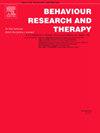在有和没有焦虑症的儿童和青少年的大样本中,消除学习和恐惧的回归
IF 4.5
2区 心理学
Q1 PSYCHOLOGY, CLINICAL
引用次数: 0
摘要
焦虑障碍是儿童和青少年最普遍的心理健康问题,因此研究其潜在机制非常重要。减少恐惧的一个关键过程,特别是在基于暴露的认知行为疗法中,是消退学习。虽然在成人中进行了广泛的研究,但其在青少年中的作用仍未得到充分探讨。本研究的目的是在一个大样本的儿童和青少年(N = 274;年龄范围8-16岁,M = 11.07, SD = 2.22; 55.8%女性)分离焦虑障碍,社交焦虑障碍和特定恐惧症(N = 217)与非焦虑对照组(N = 57)的比较中检验恐惧消退学习和恐惧回归。所有儿童都参加了为期两天的恐惧条件反射范式。使用情绪反应的主观(效价、唤醒、偶然性)和心理生理(惊吓)指标评估恐惧获得、消退和恢复。两组均可观察到成功的差异恐惧习得。随着对CS+的恐惧反应的减少,灭绝学习也取得了成功。与先前的研究结果相反,我们没有发现焦虑儿童和非焦虑儿童和青少年在恐惧消退学习方面存在差异;当CS+不再预测厌恶结果的发生时,两组都学会了抑制他们的恐惧反应。需要进一步的研究来解开恐惧消退学习在儿童焦虑障碍中的作用,并确定患有焦虑障碍的儿童是否通常没有表现出消退学习的缺陷,或者这种缺陷是否仅限于障碍特定的刺激。本文章由计算机程序翻译,如有差异,请以英文原文为准。
Extinction learning and return of fear in a large sample of children and adolescents with and without anxiety disorders
Anxiety disorders are the most prevalent mental health problems in childhood and adolescence, highlighting the importance to study their underlying mechanisms. One key process in fear reduction, particularly in exposure-based cognitive behavioral therapy, is extinction learning. While extensively studied in adults, its role in youth remains underexplored. The aim of the present study was to examine fear extinction learning and return of fear in a large sample of children and adolescents (N = 274; age range 8–16 years, M = 11.07, SD = 2.22; 55.8 % female) with separation anxiety disorder, social anxiety disorder, and specific phobia (n = 217) in comparison to non-anxious controls (n = 57). All children participated in a 2-day fear conditioning paradigm. Fear acquisition, extinction, and reinstatement were assessed using subjective (valence, arousal, contingency) and psychophysiological (startle) indicators of emotional reactivity. Successful differential fear acquisition could be observed in both groups. Extinction learning was also successful as the fear response to the CS+ decreased. Contradicting previous findings suggesting impairment in extinction in children with anxiety disorders, we could not find differences in fear extinction learning between anxious and non-anxious children and adolescents; both groups learned to inhibit their fear response when the CS+ no longer predicted the occurrence of the aversive outcome. Further research is needed to disentangle the role of fear extinction learning within childhood anxiety disorders and determine whether children with anxiety disorders generally do not show deficits in extinction learning or whether this deficit is limited to disorder specific stimuli.
求助全文
通过发布文献求助,成功后即可免费获取论文全文。
去求助
来源期刊

Behaviour Research and Therapy
PSYCHOLOGY, CLINICAL-
CiteScore
7.50
自引率
7.30%
发文量
148
期刊介绍:
The major focus of Behaviour Research and Therapy is an experimental psychopathology approach to understanding emotional and behavioral disorders and their prevention and treatment, using cognitive, behavioral, and psychophysiological (including neural) methods and models. This includes laboratory-based experimental studies with healthy, at risk and subclinical individuals that inform clinical application as well as studies with clinically severe samples. The following types of submissions are encouraged: theoretical reviews of mechanisms that contribute to psychopathology and that offer new treatment targets; tests of novel, mechanistically focused psychological interventions, especially ones that include theory-driven or experimentally-derived predictors, moderators and mediators; and innovations in dissemination and implementation of evidence-based practices into clinical practice in psychology and associated fields, especially those that target underlying mechanisms or focus on novel approaches to treatment delivery. In addition to traditional psychological disorders, the scope of the journal includes behavioural medicine (e.g., chronic pain). The journal will not consider manuscripts dealing primarily with measurement, psychometric analyses, and personality assessment.
 求助内容:
求助内容: 应助结果提醒方式:
应助结果提醒方式:


